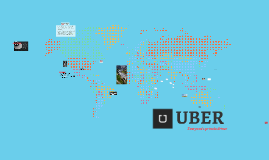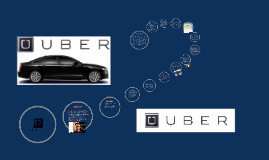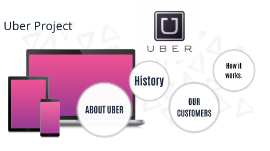Uber Presentation
Transcript: Uber was found by two friends called Garrett Camp and Travis Kalanick respectively in 2009 in San Francisco, USA. Both men had their own startups before Uber. However, in 2009 Garrett Camp began developing on a prototype of Uber as a side project. By the summer of the same year, Camp has persuaded Travis Kalanick to join Uber. After Kalanick joined, the service was tested in New York in early 2010 using only three cars, and the official launch took place in San Francisco in May. Uber is a web platform which connects the partners (drivers) with the client. This application is available on tablets and smartphones and its function is very simple. The app lets customers know where the nearest Uber vehicle is, and from there, customers can select the specific Uber vehicle of their choice. Within minutes that exact vehicle will be at the customer’s location, ready to whisk them to their desired location. As for the confirmation of the right vehicle of the client, the application sends the details of the driver, such as the name, the type of car and the estimated time of arrival. As for the payment, it is done when the client reaches his destination and is 100% paperless, meaning that the Uber app is connected to the customer’s credit card. Nevertheless, in some cities you can also pay in cash. What started as an app to request premium black cars in a few metropolitan areas is now changing the logistical fabric of cities around the world. Whether it’s a ride, a sandwich, or a package, they use technology to give people what they want, when they want it. For the women and men who drive with Uber, their app represents a flexible new way to earn money. For cities, they help strengthen local economies, improve access to transportation, and make streets safer. Of the two founders Travis Kalanick is now the CEO of Uber. Uber is Kalanick’s third entrepreneurial venture. Here are 5 lessons in leadership and life that we can learn from the man who is on a warpath to change the way people commute: You will make mistakes; Learn and move forward Do not be afraid to start small A great businesses is one that solves a problem Work towards giving people a better option Roadblocks may slow you down but don’t let them stop you Regarding Uber today, this invention is still used today and at a great extent. More specifically, Uber’s disruptive technology, explosive growth, and constant controversy make it one of the most fascinating companies to emerge over the past years. The eight-year-old company has rocketed to become the highest valued private startup company in the world. Valued by investors at $69 billion, it exceeds the market cap of giants such as General Motors, Ford and Tesla Inc., even though the company has suffered billions in losses in recent years. After Uber was invented in 2009, more ride-hailing services were developed such as the following: Hailo was founded in 2011, is UK based and operates in 16 cities around the world. Hailo is one of the fastest growing ride-hailing services in the UK. GrabTaxi was founded in 2012 and is based in Southeast Asia. GrabTaxi is one of the best apps like Uber to book your ride down Southeast with over 75,000 drivers registered on the network, GrabTaxi has one among the biggest fleets of ride-hailing vehicles. GrabTaxi is available in 30 different cities across 6 different countries in the Southeast Asia. Easy Taxi was founded in 2011 and is operating in 30 countries - 420 cities worldwide. Grabbing over 17 million users worldwide and a taxi fleet of 400,000 taxi drivers make it another great taxi-hailing alternative to Uber. Didi Dache was founded in 2012 and with over 100 million registered users, Didi Dache covers more than 300 cities across China. Although Didi Dache is priced a bit higher as compared to Uber, it is one of the most efficient and reliable cab-hailing service offered in China. LeCab was founded in 2012 and is operating only in France. As Uber is banned in France, LeCab wants to make the most of the situation and take over the ride-hailing market in France’s capital city. With over 70,000 active users and an increasing number of the vehicle fleet, LeCab is fast rising as the best ride-hailing app like Uber in France. BiTaksi was founded in 2013 and is one of the most famous taxi-hailing application in Istanbul. With over 200,000 registered users and over 34,000 taxi drivers, Bitaksi offers the best taxi-hailing service in Istanbul. Moreover, this is one of the few taxi-hailing services to have introduced in-app credit card payment system. On the contrary, the Taxi industry around the world is suffering. Uber may only be a few years old, but in many places there has a disastrous effect on the local taxi industry. For instance, in San Francisco, the city where Uber was firstly launched, Yellow Cab, the largest taxi company in San Francisco is the latest and greatest victim. As the San Francisco Examiner’s Joe Fitzgerald Rodriguez (2016) reports, the Yellow Cab will

















